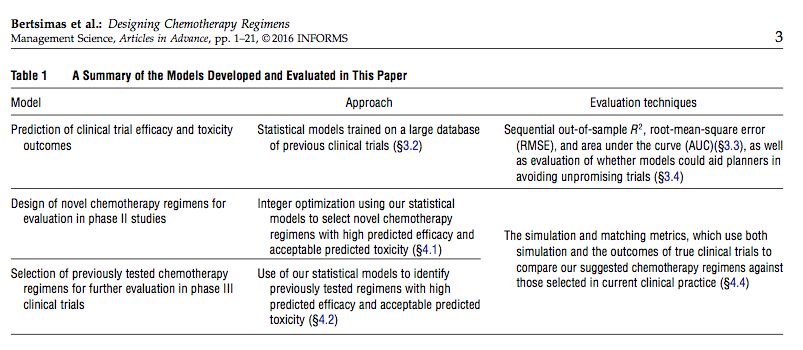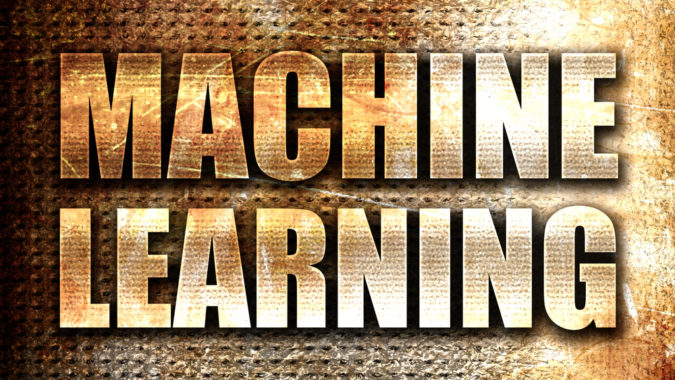Developing effective tools against cancer has been a long, complicated endeavor with successes and disappointments. Despite all, cancer remains the leading cause of death worldwide. Now, machine learning and data analytics are being recruited as tools in the effort fight the disease and show significant promise according to two recent papers.
In one paper – An Analytics Approach to Designing Combination Chemotherapy Regimens for Cancer – researchers from MIT and Stanford “propose models that use machine learning and optimization to suggest regimens to be tested in phase II and phase III trials.” Their work, published in March in Management Science, could help cut costs and speed clinical trials. Importantly, it and focuses on combination therapy, perhaps the toughest to model but which has proven the more effective for most cancers.
The second study, by researchers from Regenstrief Institute and Indiana University School of Informatics and Computing, found that existing algorithms and open source machine learning tools were as good or better than human reviewers in detecting cancer cases using data from free-text pathology reports. Moreover, the computerized approach was faster and less resource intensive in comparison to human counterparts.
This latter study – Towards Better Public Health Reporting Using Existing Off the Shelf Approaches: A Comparison of Alternative Cancer Detection Approaches Using Plaintext Medical Data and Non-dictionary Based Feature Selection – was published last month in Journal of Biomedical Informatics.
The cancer challenge, of course, isn’t new. Cancer kills roughly nine million people each year. While advancing genomics and molecular medicine have made great strides in revealing many of cancer’s underlying causes and proven effective in many cases, definitive cures have remained mostly elusive. One reason is simply there are so many cancers; another is even a single tumor may have many different mutations, each sensitive to a different therapy.
It now turns out that machine learning and analytics may well prove to be especially valuable in approaching cancer drug development and therapy selections. Data mining has certainly been applied before but the confluence of appropriate technologies (analytics and compute) along with sufficient quantities of clinical data and outcomes data are key enablers.
In the first study the focus was on gastric cancer. The authors note that individualized predictions, using their methods, represent a useful tool to patients choosing between multiple treatment options and, when trained on clinical trial outcomes for a particular treatment, can be used to identify promising patient populations on which to test that treatment or to determine if that treatment is promising for a phase III clinical trial. The MIT-Stanford team emphasizes what they think are three “major contributions” their work provides, excerpted below:
- “Clinical Trial Database. We developed a database containing information about the patient demographics, study characteristics, chemotherapy regimens tested, and outcomes of all phase II and phase III clinical trials for advanced gastric cancer from papers published in the period 1979–2012. Surprisingly, and to the best of our knowledge, such a database did not exist before this study.
- “Statistical Models Predicting Clinical Trial Outcomes. We train statistical models using the results of previous randomized and nonrandomized clinical trials. We use these models to predict survival and toxicity outcomes of new clinical trials evaluating regimens whose drugs have individually been tested before, but potentially in different combinations or dosages. To our knowledge, this is the first paper to employ statistical models for the prediction of clinical trial outcomes of arbitrary drug combinations and to perform an out-of-sample evaluation of the predictions.
- “Design of Chemotherapy Regimens. We propose and evaluate tools for suggesting novel chemotherapy regimens to be tested in phase II studies and for selecting previously tested regimens to be further evaluated in phase III clinical trials. Our methodology balances the dual objectives of exploring novel chemotherapy regimens and testing treatments predicted to be highly effective. To our knowledge, this is the first use of statistical models and optimization to design novel chemotherapy regimens based on the results of previous clinical trials.”
The authors note it is inherently challenging to evaluate the performance of their models without actually running clinical trials and they use two techniques to obtain estimates for the quality of regimens selected by their models compared with those actually tested in current clinical practice. “Both techniques indicate that the models might improve the efficacy of the regimens selected for testing in phase III clinical trials without changing toxicity outcomes,” they write. “This evaluation of the proposed models suggests that they merit further testing in a clinical trial setting.”

Their study should be read in full as the authors present their methods in detail and their assessment of varying approaches. Listed authors include: Dimitris Bertsimas, Sloan School and Operations Research Center, MIT; Allison O’Hair, Stanford Graduate School of Business; Stephen Relyea, Lincoln Laboratory, MIT; and John Silberholz, Sloan School and Operations Research Center, MIT.
In the second study, researchers found the commonly used algorithms equaled or exceed pathologists in detecting cancer.
“We think that its no longer necessary for humans to spend time reviewing text reports to determine if cancer is present or not,” said study senior author Shaun Grannis, interim director of the Regenstrief Center of Biomedical Informatics. “We have come to the point in time that technology can handle this. A human’s time is better spent helping other humans by providing them with better clinical care.”
“A lot of the work that we will be doing in informatics in the next few years will be focused on how we can benefit from machine learning and artificial intelligence. Everything – physician practices, health care systems, health information exchanges, insurers, as well as public health departments – are awash in oceans of data. How can we hope to make sense of this deluge of data? Humans can’t do it – but computers can.”
The researchers sampled 7,000 free-text pathology reports from over 30 hospitals that participate in the Indiana Health Information Exchange and used open source tools, classification algorithms, and varying feature selection approaches to predict if a report was positive or negative for cancer. The results indicated that a fully automated review yielded results similar or better than those of trained human reviewers, saving both time and money.
The study evaluated the capacity to detect cancer cases from the reports using three non-dictionary feature selection approaches, four feature subset sizes, and five clinical decision models: simple logistic regression, naive bayes, k-nearest neighbor, random forest, and J48 decision tree. The performance of each decision model was evaluated using sensitivity, specificity, accuracy, positive predictive value, and area under the receiver operating characteristics (ROC) curve.

“Machine learning can now support ideas and concepts that we have been aware of for decades, such as a basic understanding of medical terms,” said Grannis. “We found that artificial intelligence was as least as accurate as humans in identifying cancer cases from free-text clinical data. For example the computer ‘learned’ that the word ‘sheet’ or ‘sheets’ signified cancer as ‘sheet’ or ‘sheets of cells’ are used in pathology reports to indicate malignancy.
Grannis emphasized the team’s work “is not an advance in ideas, it’s a major infrastructure advance — we have the technology, we have the data, we have the software from which we saw accurate, rapid review of vast amounts of data without human oversight or supervision.”
The study was conducted with support from the Centers for Disease Control and Prevention. In addition to Grannis, co-authors of the study are Brian E. Dixon (Regenstrief Institute), Huiping Xu (IU Fairbanks School of Public Health), Judy Gichoya (Regenstrief Institute), Burke Mamlin (IU School of Medicine), Yuni Xian (School of Science, IUPUI), and Suranga N. Kasthurirathne (a doctoral student at School of Informatics and Computing at IUPUI).
Link to first paper discussed, An Analytics Approach to Designing Combination Chemotherapy Regimens for Cancer, http://www.mit.edu/~dbertsim/papers/HealthCare/An%20Analytics%20Approach%20to%20Designing%20Clinical%20Trials%20for%20Cancer.pdf
Link to second paper discussed, Towards Better Public Health Reporting Using Existing Off the Shelf Approaches: A Comparison of Alternative Cancer Detection Approaches Using Plaintext Medical Data and Non-dictionary Based Feature Selection, published in Journal of Biomedical Informatics, http://www.sciencedirect.com/science/article/pii/S1532046416000095





























































